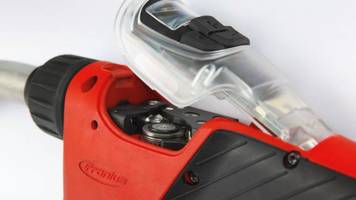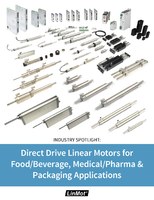It's Cool Man

Weighing just 1,600 grams, the new PullMig welding torch from Fronius is incredibly light for a push-pull welding torch. Not only that, the developers have also succeeded in making it extremely robust: it can survive a fall from 3 metres completely unscathed. The stainless steel outer tube and anti-twist device in the zero degree position ensure that the torch neck, which rotates 360°, remains extremely stable even in the event of harsh impacts with the workpiece. Several structural changes have improved the thermal dissipation while also reducing the absorption of arc radiant heat. As a result, overall the welding torch remains cooler than its predecessor and the gas nozzle can be handled safely without gloves approximately one and a half minutes after welding (500 A). The wire feeding of the new PullMig welding torch is even more precise, which means that users can benefit from the rapid arc control of the most advanced MIG/MAG welding device platform from Fronius, the TPS/i, without any restrictions. Despite its sophistication, the welding torch is even easier to handle in all aspects. For example, users no longer need to open the handle to thread a new wire. Time-consuming synchronisation of the feeder motors is no longer necessary as this is now taken care of automatically by the power source. What's more, Fronius has continued to optimise all wearing parts to achieve cost savings and simpler work procedures.
Weighing just 1,600 grams, the new PullMig welding torch from Fronius is incredibly light for a push-pull welding torch. Not only that, the developers have also succeeded in making it extremely robust: it can survive a fall from 3 metres completely unscathed. The stainless steel outer tube and anti-twist device in the zero degree position ensure that the torch neck, which rotates 360°, remains extremely stable even in the event of harsh impacts with the workpiece. Several structural changes have improved the thermal dissipation while also reducing the absorption of arc radiant heat. As a result, overall the welding torch remains cooler than its predecessor and the gas nozzle can be handled safely without gloves approximately one and a half minutes after welding (500 A). The wire feeding of the new PullMig welding torch is even more precise, which means that users can benefit from the rapid arc control of the most advanced MIG/MAG welding device platform from Fronius, the TPS/i, without any restrictions. Despite its sophistication, the welding torch is even easier to handle in all aspects. For example, users no longer need to open the handle to thread a new wire. Time-consuming synchronisation of the feeder motors is no longer necessary as this is now taken care of automatically by the power source. What's more, Fronius has continued to optimise all wearing parts to achieve cost savings and simpler work procedures.
The new push-pull welding torch from Fronius is an impressive 600 grams lighter than its predecessor. Weighing just 400 g more than a standard push welding torch, it delivers impressive performance benefits. The main element of the decreased weight is the motor for the pull unit which is housed in the torch handle and was co-developed by Fronius. Not only is the brushless servomotor considerably more dynamic, it enables more precise control than the standard DC motors which used to be common in the industry and is also significantly more compact with a longer service life. If that's not enough, the motor has also been equipped with actual value pick-up for the first time and it is connected to the power source via a high-speed bus. This means that synchronisation of the two PushPull system wirefeeder motors, which was previously carried out manually, is now fully automatic. Thanks to device IDs, the power source independently detects the type of welding torch in use and determines whether calibration is required. Furthermore, both drive rollers of the new PullMig are powered in the handle. Together with a special contour, this ensures that the system securely grips the wire and transports it through the push unit. To thread the wire, it is no longer necessary to open the welding torch or the drive rollers. All of this makes the PullMig from Fronius the first welding torch that is as easy to handle as a simple push welding torch.
By extending the cooling ducts in the direction of the contact tip and providing additional cooling of the external sleeve along with a screwed rather than plugged-in gas shroud, it has been possible to considerably increase the cooling capacity of the PullMig welding torch. In addition, the multi-lock connection features an integrated water stop. This prevents the cooling water from escaping when the torch neck is changed while also closing the cooling circuit so that water can continue to be cooled in the circuit. The contact tip is now narrower to reduce the amount of arc radiant heat that is absorbed. This design feature alone keeps the welding torch cooler. This means that the arc is more stable and less cooling power is required. And, it takes considerably longer for the contact tip to wear down. Initial practical tests have demonstrated that this delivers a tenfold increase in the service life. This increases system availability and helps users to cut costs.
Fronius has also successfully achieved additional cost savings in relation to the inner liners: a clamp system built into the torch body and improved clamping elements mean that inner liners can be changed without tools and unassembled inner liners can be used (by the metre). To ensure maximum precision during wire feeding, inner liners which match the diameter of the wire used are also now used in the hosepack. Identification of the corresponding wire guiding system parts is simplified thanks to consistent colour coding.
The welding torches, which are designed to be operated with a welding power of up to max. 280 A (40% D.C.) for gas cooling and 320 A (100% D.C.) for water cooling, are available now and can be ordered as versions without additional functions (standard) or with remote control (Up/Down and/or JobMaster function) in the handle.




